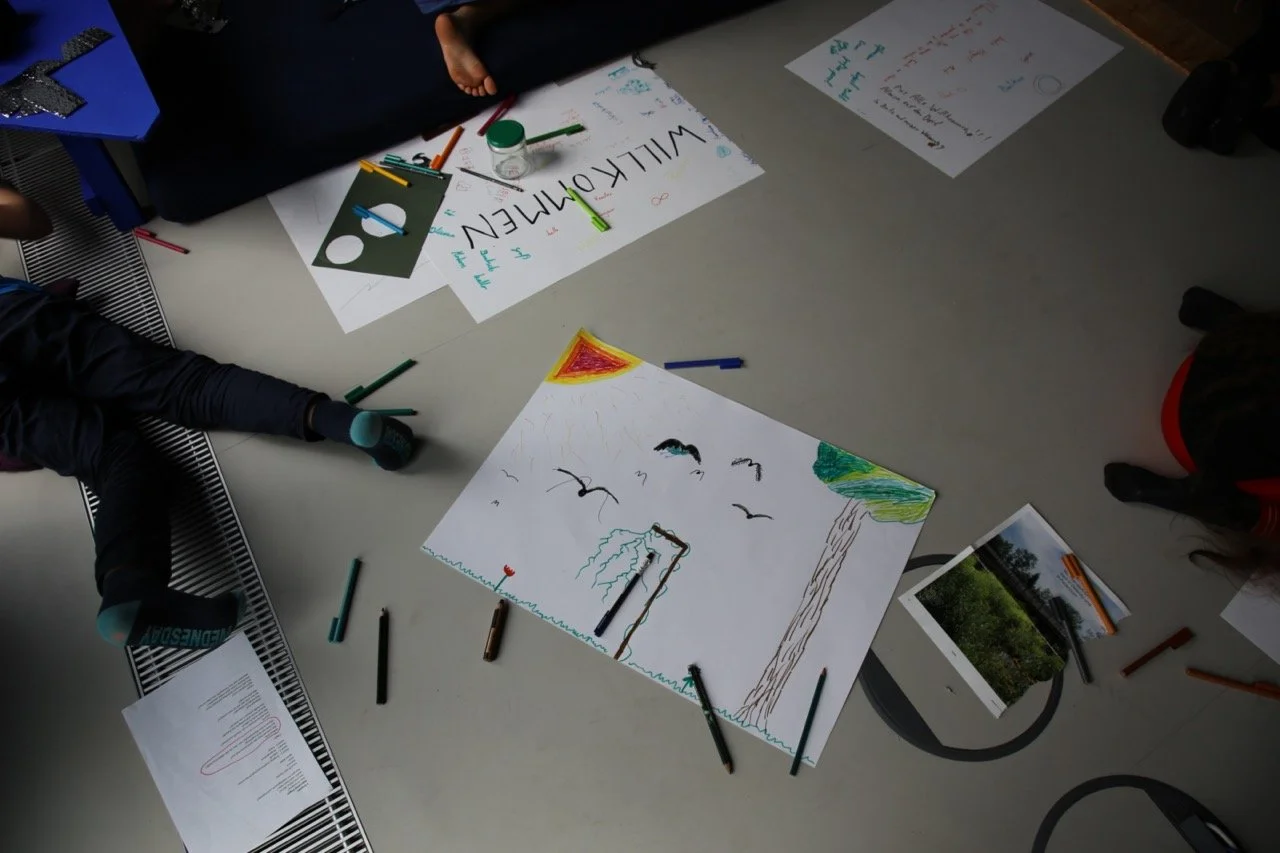David Krippendorff and the feeling of home
Today we come to the Ephra floor a little sad, because it's our last day here for the time being. Today's theme fits like a glove: “Heimat”, the place where you feel at home.
The artist visiting us today is called David Krippendorff and makes video art. His video works often deal with the themes of loss, identity and home, as in the video work "There is no place like home", which he shows us first. Based on a scene from the film "The Wizard of Oz", we see how a farmhouse – Dorothy's home – whirled up by a tornado and slowly flying through the air. The scene seems to go on forever and is repeated again and again. The inside of the house is only shown briefly. And then it starts all over again. The video has no real beginning or end. We want to know why this video only consists of two scenes. David explains that his family lives in many different places. He was born in Italy. When he was twenty years old, he moved to Germany with his parents. Another part of his family lives in the UK and in America. As a child and to this day, he finds it difficult to say exactly where his home is. Does he feel more at home in Italy or Germany? Or is it somewhere else entirely? These questions have always bothered him, which is why he loved the “Wizard of Oz” as a child. The “Wizard of Oz” is about an orphan girl, Dorothy, who is looking for safety and a home. The house, which we also see in David’s video and in which Dorothy lives, is lifted into the air by a tornado and lands on Oz. Although the new world is colourful, friendly and diverse, she desperately wants to return home. To do this, however, she has to go to the wizard and ask him for help. On the way there and through the adventures Dorothy experiences, she makes new friends in Oz. Despite the cosy feeling that her friends give her, Dorothy ends up asking a fairy godmother to take her back home. She concludes: “There’s no place like home”. The longer David’s video runs, the more we realise that it is not so pleasant to watch for a long time: The repetition of the same scenes over and over again, the black and white, the drawn-out, distorted sound – it all feels exhausting for us. But David explains that that is exactely what he senses when he feels uprooted and believes he doesn’t really belong anywhere.
But what does home, this special place, feel like? To get closer to this feeling, we split into four groups. Each group gets its own giant piece of cardboard. The four pieces of cardboard will later be put together to form the walls of a house. We choose a term for each group: Past, welcome, dream and future. We want to combine these with the question of what home feels like to us. To do this, we first talk about the terms. We think about what things have made us feel safe in the past or who or what we would like to remember. We talk about our cuddly toys, some of which have been with us forever and lie in our bed every night, and about certain dishes that remind us directly of home and make us feel cosy. For one it’s dad’s homemade gnocchi, for the other mum’s lasagne. To transfer our thoughts onto the large cardboard, we are allowed to use anything we can find on the Ephra floor: Pens, coloured papers, foils, cardboard, string and, so on. It’s not easy to get started with all the possibilities. We colour in all the things that remind us of home and stick them on the cardboard wall. We also cut out windows and doors, put stickers on the walls and decorate everything with balloons, glitter foil and fabric.
At the very end, place all four walls so that they form a square. We connect them together with cable ties and put a cardboard roof on top. Now we can finally explore our whole house and see how the walls of the other groups are designed. The welcome group has made a real door that can be opened and closed. Next to the door sits a dog and a big sign says “All are welcome”. The group then wrote "Hello" and other greetings in different languages. There are little matchboxes stuck to the future wall where you can put your wishes for the future. We can communicate from the inside to the outside through a pipe in the wall and vice versa. On their wall, the dream group dreams of a home with lots of friends, "where everyone has the chance to get in, but you can also get out again if you want to”, explains one of us. The animals were also taken into consideration: a dog with a speech bubble says “Freedom is important” and next to another dog is written “All animals have rights”. We also decorated the roof with a sun and birds. We think that our house should be as cosy as a real home and so we hang a string of lights inside at the end. With a bit of squashing and squeezing, we now all fit into our Ephra house.
David has shown us today that home can mean lots of different things and feelings. Some images are similar, others are very different. But we all know that this cosy feeling of security is something very special that cannot be replaced by anything else.









